When Returning from Open Sea: Red Buoy Response Guide
Navigating the waters after returning from open sea can be challenging, especially when encountering various buoys and markers that are crucial for marine safety. One such important marker is the red buoy. Understanding how to respond to a red buoy when returning to port from seaward is vital for both safe navigation and legal compliance.
As a boater, it is important to be familiar with the various navigational aids, such as lateral markers, red and green buoys, and their respective roles in guiding vessels through designated channels.

Red buoys serve as starboard hand buoys, with their colors, lights, and even numbers marking the edge of a channel on the boat's starboard side when entering a harbor, heading upstream, or entering a channel from seaward.
To respond correctly, it is essential to slow down upon approaching a red buoy, maintain a safe distance, and keep the marker on the right side of the boat to avoid potential hazards and stay within the designated channel.
Key Takeaways
- Red buoys indicate the starboard edge of a channel when returning from open sea
- Keeping the red buoy on the right side of the boat ensures safe navigation
- Slowing down and maintaining a safe distance prevents potential hazards and legal issues
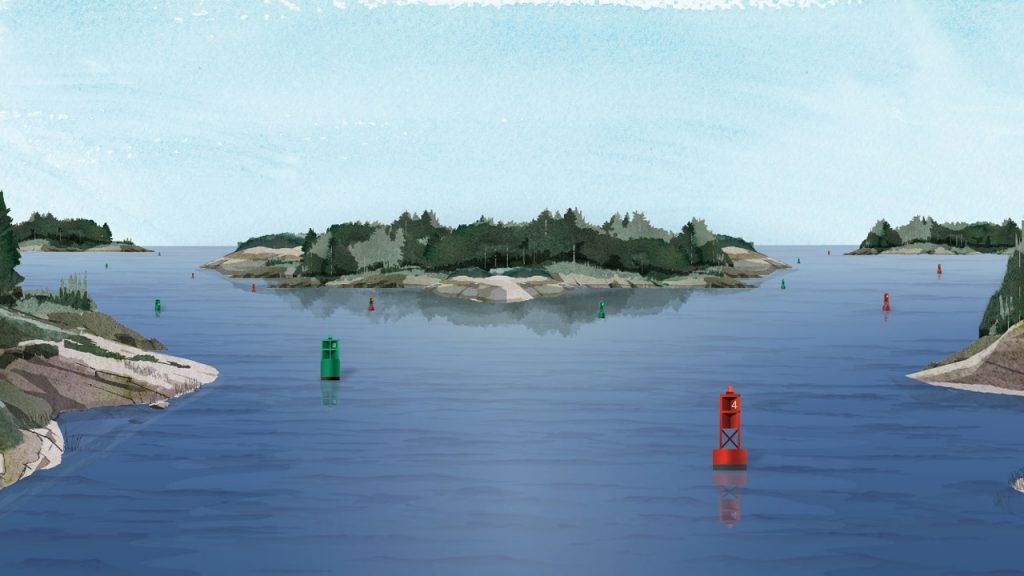
Understanding Buoys and Markers
Definition of Buoys
Buoys are floating devices placed on water to serve as navigational aids for vessels. They come in various colors, shapes, and sizes, each with their specific purpose in helping boaters identify safe water zones and where designated channels are located.
Red Buoys
When returning from open sea and encountering a red buoy, it signifies a starboard hand buoy, meaning it is on your right side as you enter a channel from seaward or head upstream. Red buoys are designed to guide boats safely through channels by indicating the right side of the passage.
Marker Buoy
A marker buoy is a floating object designed to convey information about a particular area on the water. This includes information on dangers, restrictions, and directions. They utilise distinctive shapes, colors, and markings to convey the information, ensuring vessel safety and guiding boaters towards the designated channel.
Lateral Markers
Green buoys and red buoys are also called lateral markers, which indicate the edges of safe water areas. Green buoys, green lights, and odd numbers mark the edge of a channel on your port (left) side when entering from open sea or heading upstream. The numbers on these markers usually increase as you head upstream.
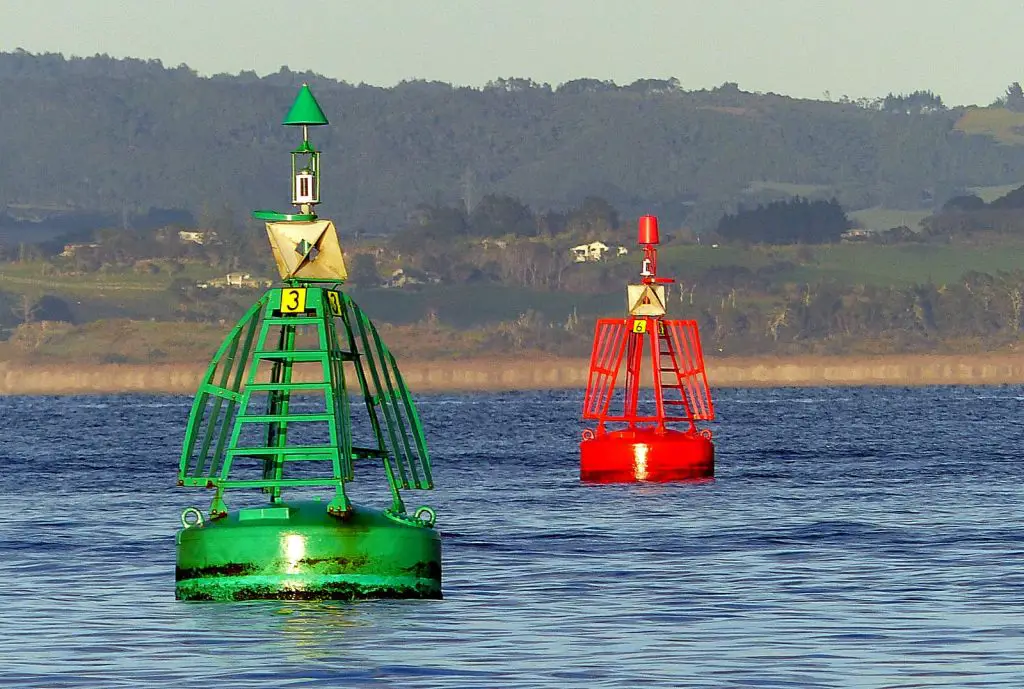
Green Buoys
Green buoys function in conjunction with red buoys to create a navigational pathway for boats. When returning to port from seaward, green buoys should be kept on the left side of your vessel. Can buoys, which are cylinder-shaped, serve as one type of green marker utilized in lateral marker systems.
Safe Water Zones
Safe water zones are areas marked by buoys and markers to ensure safe navigation for vessels. These regions are free from hazards and obstructions, allowing boaters to proceed with confidence. By following the guidance provided by both red and green buoys, boaters can navigate through channels safely and efficiently.
Yellow Buoys
Yellow buoys come into play when marking special areas on the water. These buoys often inform boaters about specific hazards, restricted zones, or fishing areas. Yellow buoys help in ensuring that vessels avoid potential dangers while following established routes designated by other navigational aids, such as red and green buoys.

Navigational Aids and Direction
Channel Markers
When returning to port from open sea, boaters may encounter channel markers, such as red and green buoys. These lateral markers designate the boundaries of a channel and help guide vessels through safe passages. In general, when moving from open water to inland water or heading upstream, red markers should be on the right side, while green markers should be on the left side.
Navigation Aid
A red buoy is a type of navigation aid used to mark the edge of a channel. Boaters should be aware of these marker positions to safely navigate coastal waters. Upon encountering a red buoy, it's essential to slow down the vessel and maintain a safe distance. This will allow more time to assess the situation and take appropriate action to navigate the area.
Safe Navigation
Maintaining a slow speed is crucial for safe navigation through coastal waters and inland channels. By keeping the red buoy to the starboard (right) side and the green markers to the port (left) side, vessels can safely steer through designated channels, avoiding potential hazards and shallow waters. Boaters should always be vigilant and mindful of other vessels and navigation aids throughout their journey.
Navigational Aids
The "Red Right Returning" rule is an essential aspect of lateral navigation in the United States. This rule states that when returning or proceeding upstream, the red even-numbered markers should be kept to the right, while the green odd-numbered markers should be kept to the left. In addition to red and green buoys, other navigational aids include day beacons, range markers, and lighted aids. These aids help ensure the safe and efficient movement of vessels through waterways and channels.
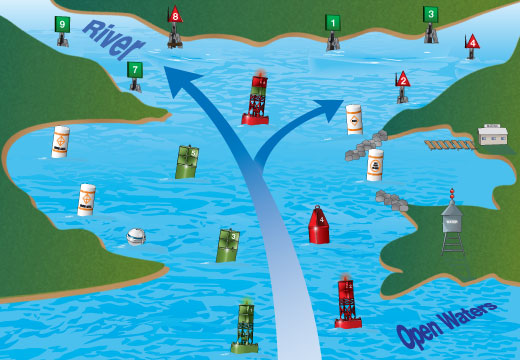
Approaching from Open Sea
Entering a Channel
When returning from the open sea and encountering a red buoy, you are likely entering a channel. Red buoys serve as lateral markers to denote the edges of a channel, making it easier for boaters to navigate the waterway safely. These markers are typically used in conjunction with green lateral markers to guide vessels through the channel. As you approach, slow down your vessel and maintain a safe distance. This will allow you to assess the situation and take appropriate action.
Running Aground
One of the risks when approaching a channel from the open sea is running aground. By paying close attention to the red and green lateral markers, you can reduce the chance of grounding your vessel. Make sure to maintain a safe depth by using navigational aids, such as depth sounders or charts, and remain vigilant in observing the buoys marking the channel.
Passing Buoys on the Right Side
As you enter the channel from the open sea, you should follow the "Red, Right, Return" rule. This means to keep the red buoy on your right hand (starboard) side when returning to port. Maintaining this orientation will ensure that you are in the correct position within the channel and decrease the chance of navigational errors.
Red, Right, Return
The "Red, Right, Return" rule is a basic navigational principle to remember when approaching a channel from the open sea. By keeping the red buoys on your right side, you can easily identify the safe route through the channel and avoid hazards or shallow waters. This rule is especially important as you navigate through unfamiliar waterways or during times of limited visibility.

Identifying Potential Hazards
Rocks and Shoals
When returning from the open sea and encountering a red buoy, boaters should be aware of potential hazards such as rocks and shoals. These submerged obstacles can damage or even ground a boat, putting the vessel and its passengers at risk. Staying within the marked channel provided by the lateral markers can help avoid these treacherous areas.
Shallow Water
Another hazard to watch for is shallow water, which can be indicated by the red and green buoys marking the channel. It's crucial to pay attention to your boat's depth finder and charts, as straying from the channel could lead to running aground in shallow areas. Always maintain a safe depth while navigating waters marked by lateral markers.
Recognizing Danger Signals
It's essential for boaters to understand and recognize danger signals while returning from open sea. For example, a red buoy with an even number indicates the right side of the channel when heading upstream. Knowing this, along with other importantsignals provided by buoys, can help to identify potential hazards ahead and avoid accidents.
Caution and Prevention
Maintaining a cautious and preventive approach while navigating the waters is the key to ensuring boater safety. This includes:
- Regularly checking your navigation charts and depth finder
- Always keeping an eye out for changing conditions or unexpected obstacles
- Staying within the channel marked by red and green buoys
By taking these precautions and staying informed, boaters can better protect themselves and others from the potential hazards that may be encountered when returning from open sea.

Legal Aspects and Safety
Legal Consequences
When returning from the open sea and encountering a red buoy, boaters should be aware of the legal consequences of not abiding by the proper navigation rules. Navigational markers, such as red buoys, are essential for maintaining safety and ensuring the smooth flow of maritime traffic. Failure to follow these markers could lead to potential collisions or running aground, which may result in legal penalties or damage to property.
Interaction with Local Authorities
Local authorities are responsible for enforcing maritime laws and regulations. When returning from the open sea and encountering a red buoy, boaters should be prepared to interact and cooperate with these authorities if necessary. This may include providing details about the vessel, its route, or any incidents that occurred during the voyage. Compliance with local authorities will reduce the risk of fines or other penalties.
Safety Measures and Precautions
To ensure safety when approaching a red buoy from the open sea, it is essential to take certain measures and precautions. These include:
- Reducing speed: Slower vessels are easier to maneuver and control, allowing more time to assess the situation and take appropriate action (source).
- Maintaining a safe distance: Keeping a safe distance from navigational markers helps prevent accidental damage to the vessel or the marker itself.
- Following the "Red, Right, Returning" rule: When returning from seaward, keep red buoys on the right (starboard) side of the boat to avoid running aground (source).
Potential Penalties
Failure to respond properly to a red buoy when returning from the open sea may result in various penalties, such as fines, vessel impoundment, or even suspension of a boating license. It is crucial for boaters to be aware of these potential penalties and always adhere to maritime laws and regulations. This will not only ensure the safety of their vessel and crew, but also contribute to a safe and efficient navigation environment for all.

Role of Lights and Numbers
Use of Red and Green Lights
When returning from the open sea and encountering a red buoy, it's essential to understand the use of red and green lights. Red and green lights, also known as lateral markers, indicate the edges of a channel. Red lights and buoys are placed on the starboard (right) side of the channel, while green lights and buoys are located on the port (left) side.
Odd and Even Numbers
Both red and green buoys are often marked with odd and even numbers to help boaters determine the direction of the channel. Red buoys with even numbers indicate the starboard side, and green buoys with odd numbers indicate the port side. The numbers usually increase as you head upstream or return from the open sea, guiding mariners through the channel.
Channel Splits and Junction Buoys
In some cases, channels may split or join, requiring a different type of buoy known as junction buoys to help boaters navigate. Junction buoys, often painted with both red and green colors, alert mariners to the presence of a channel split or a channel confluence. By identifying the correct side of the junction buoy to pass, mariners can safely navigate through these more complex sections of the waterway.
In conclusion, when returning from open sea and seeing a red buoy, it's crucial to understand the role of lights and numbers in lateral markers. By paying attention to the red and green lights, odd and even numbers, as well as junction buoys, boaters can safely and confidently navigate through channels and waterways.
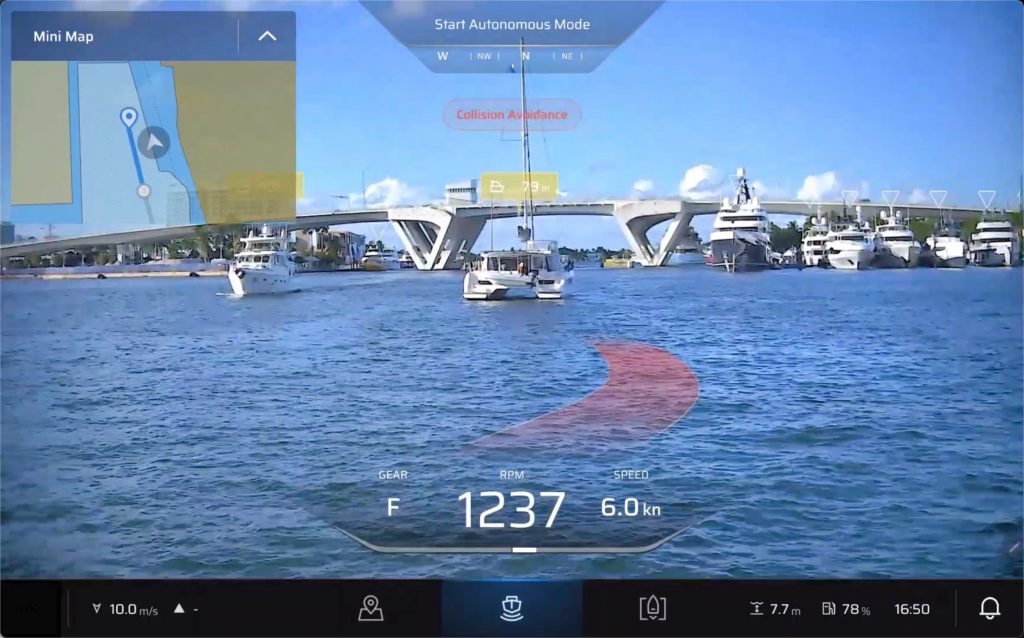
Understanding Designated Routes
When navigating the waters, it is crucial for boaters to understand designated routes and recognize various markers, such as red buoys. This section will discuss three key aspects of designated routes: Designated Channel, Inland Water Routes, and Harbor and Port Ecosystem.
Designated Channel
A designated channel is a specific path marked by lateral markers to guide boats through a particular waterway. These markers, such as red and green buoys, help boaters determine which side of the channel they should pass on to stay on course. Navigating within the designated channel ensures that vessels avoid hazards and maintain a safe route.
- Red buoys: Mark the right side of the channel when returning from open sea
- Green buoys: Mark the left side of the channel when returning from open sea
Inland Water Routes
Inland water routes are a network of navigable waterways that connect to larger bodies of water, such as seas and oceans. These routes usually consist of rivers, canals, and lakes, providing access to different regions for transportation and recreational purposes. Understanding the appropriate lateral markers is vital in maintaining a safe course within inland water routes:
- Red markers with even numbers are placed along the starboard (right) side of a channel when entering from the open sea or moving upstream
- Green markers with odd numbers, on the other hand, are placed along the port (left) side of the channel
Harbor and Port Ecosystem
A harbor or port is a designated area where boats can safely anchor, dock, and access necessary services such as fuel, repairs, and supplies. The harbor and port ecosystem is specifically designed to accommodate different types of vessels, from small recreational boats to large cargo ships.
In these areas, navigational aids like buoys, channel markers, and navigational lights play a crucial role in guiding vessels through the designated routes. Maintaining vigilance and abiding by the established navigation system ensures a safe and efficient maritime environment for everyone.
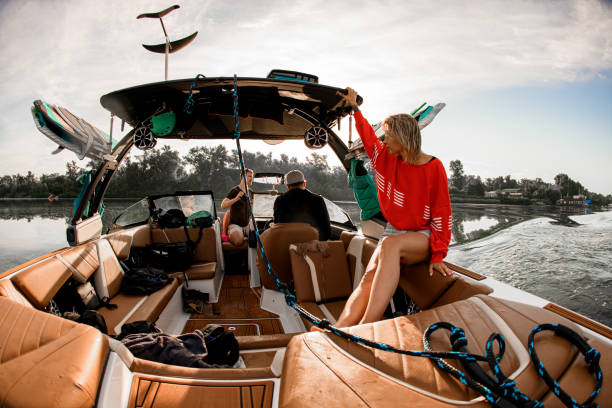
Frequently Asked Questions
How should you navigate around a red buoy when returning from open sea?
When returning from the open sea and encountering a red buoy, boaters should approach and navigate around the buoy on their starboard (right) side, as red buoys typically indicate the edge of a channel on a boat's starboard side when heading toward a harbor or upstream. This helps to ensure safe passage through the channel.
What side of a red buoy should you pass when heading toward a harbor?
While heading toward a harbor or upstream, boaters should pass a red buoy on their starboard (right) side. This is because red buoys, also known as starboard hand buoys, mark the edge of the navigable channel on a boat's starboard side when returning from open sea or going upstream source.
What do red buoys indicate in a channel?
Red buoys in a channel serve as lateral markers, indicating the edge of the navigable channel on a boat's starboard side. They help boaters stay on course by providing visual guidance and ensuring a safe passage through the channel source.
What is the function of red buoys in nautical navigation?
The primary function of red buoys in nautical navigation is to mark the edge of a navigable channel on a boat's starboard side when heading toward a harbor or upstream. They act as visual guides for boaters to maintain a safe course and avoid potential hazards source.
How does the buoy system work when navigating back to shore?
The buoy system consists of various types of markers, including red and green buoys that serve as lateral markers, guiding boaters through navigable channels. When returning to shore, boaters should approach and pass red buoys on their starboard side and green buoys on their port (left) side. This system helps boaters maintain a safe course and avoid obstacles source.
What does a red buoy with an even number signify in US waters?
In US waters, a red buoy with an even number signifies a navigational marker on a boat's starboard side when heading toward a harbor or upstream. The even number indicates the edge of a channel on the boat's starboard side, with the number increasing as boaters return from open water or go upstream source.
Charlie is Editor-in-Chief of Sea Magazine